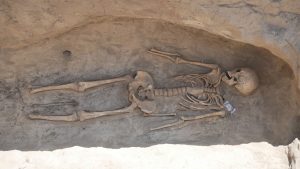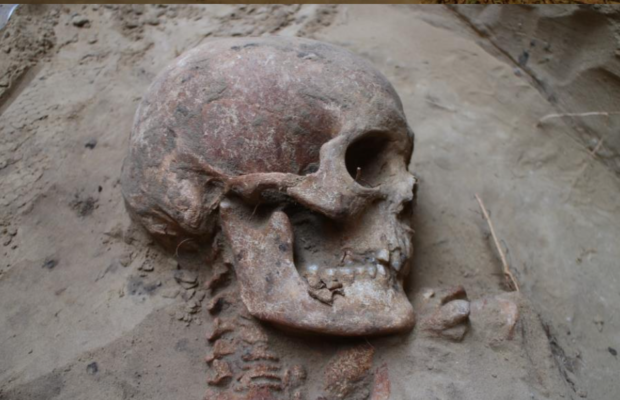In July-August, during excavations and exploration of a small mound on Mount Mamai, archaeologists came across a trench with remains of animal bones and small fragments of amphorae. These constitute clear signs of a mourning celebration characteristic of the Scythians and other ancient cultures.

Further excavation revealed two graves – a larger central burial pit and a smaller one. At first, the archeological team decided to clear the smaller one. It took almost three days.
While dusting and cleaning the contours of the pit, the archaeologists came across a rare gray clay amphora.
In the pit lay a skeleton, which, as later revealed by anthropologists, belonged to a young man aged 18-20 years.

Judging by the objects lying nearby, he was a Scythian* warrior and horseman. The archeologists also discovered an iron axe, bronze and bone arrows, and bridle buckles. The most interesting artifact is a gold-plated akinakes (Scythian dagger/short sword) with a leaf-ribbed grip, a cross-guard and a scabbard for the blade tip.
(*The Scythian were a nomadic Indo-European people, of Eastern European origin occupying a geological band from the Eastern Europe through to the grasslands above China; they shared a common artistic, cultural, & economic base-Ed)
Not only had the young warrior been buried together with his weapons, but also with some ornaments; the archeological team found beads made of glass paste, a red deer tooth necklace, a gold earring and a gold pendant with chalk inlay.
“This grave was adjacent to another, much larger tomb, which had been looted some time ago. We found an arrow tip and bone fragments. An elderly man had been buried here. It’s quite possible that this 18-20-year-old warrior could have been escorting a prominent leader.” say the archeologists.
Not only is the dig important because of its ancient treasures and weapons, but it also brings more specific information on the dating of Scythian findings in Mount Mamai area. Experts date this burial site further back in time – from the 6th century B.C., whereas previous Scythian findings were dated from the 4th-3rd century B.C.
For some time, the excavations work was kept secret as experts and researchers restored artifacts and conducted further studies. On September 26, the heads of the archaeological expedition of the Zaporizhzhia National University, Hennadiy Toshchev and Svitlana Andrukh held a press conference to explain the Scythian burial grounds.
The 32nd archeological season at Mount Mamai has been called the most successful of all.
The artifacts will be preserved in the Museum of Local History in Kamianets-Dniprovsky.
Mamai Hora (Mount Mamai) is the most important multi-complex burial mound in the Northern Black Sea region, as well as one of the largest ancient burial sites in Europe. It is located on the left bank of the Khakhovka Reservoir near the village of Velyka Znamianka in Kamianets-Dniprovsky Raion, Zaporizhzhia Oblast. Archeological teams have discovered an impressive array of artefacts dating back to the Neolithic period, Bronze Age, Early Iron Age, Middle Ages, in other words, regional history spanning about 8,000 years.
It is possible that the original footprint of the site was substantially larger, but has been reduced considerably due to the loss of more than 300 metres of shoreline after the Kakhovka Reservoir was created.
Unfortunately, the shoreline continues to slide into the reservoir. Over the past 30 years, nearly 400 metres have dropped into the water. Scientists say that it is impossible to stop this process. Therefore, since 1988, archeological teams from the Faculty of History of Zaporizhzhia National University have been continuously carrying out digs and salvage work on the site.
Video about excavations at Mamai Hora (in Ukrainian, 10 min)
[embedyt] https://www.youtube.com/watch?v=nqBePpTbYkU[/embedyt]























